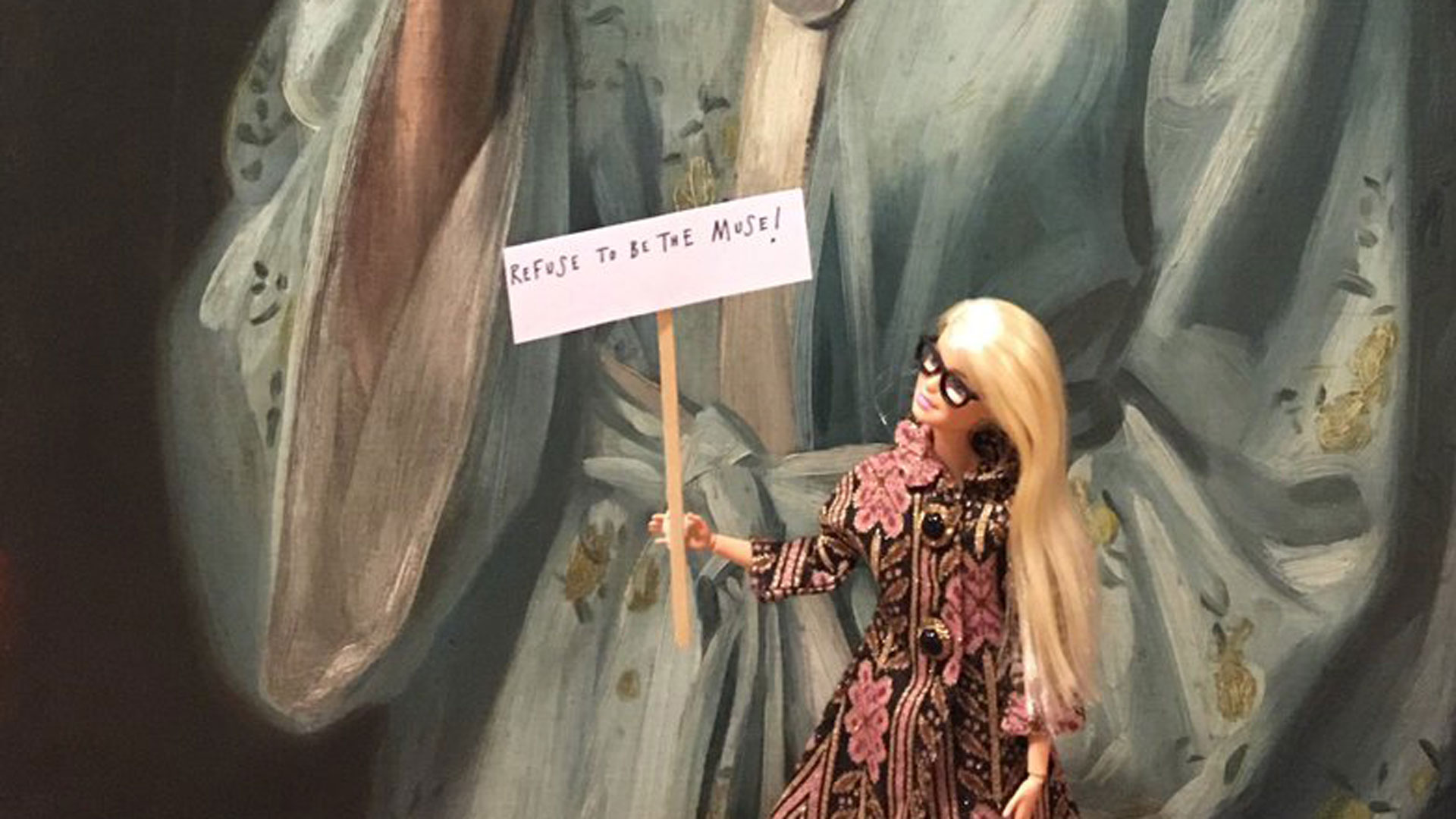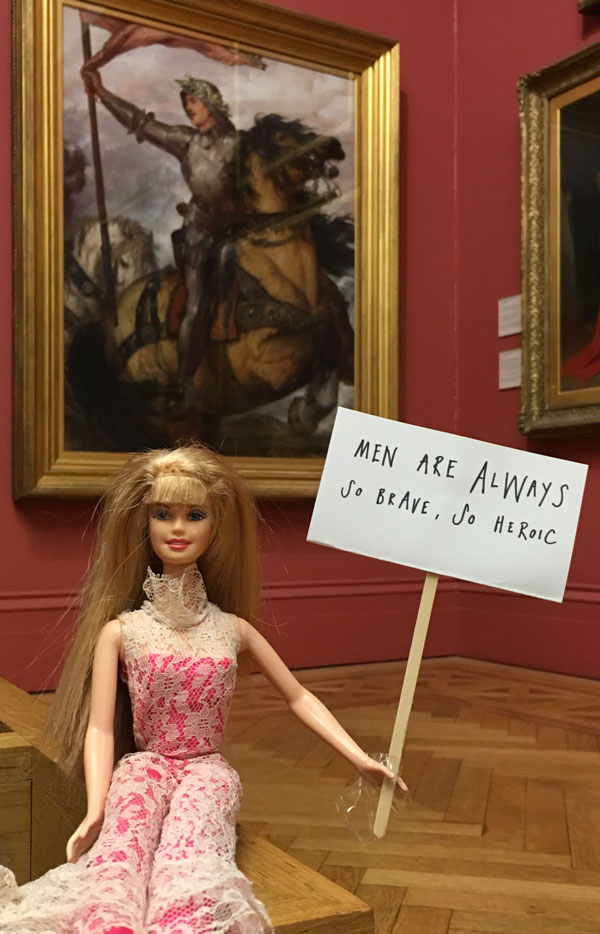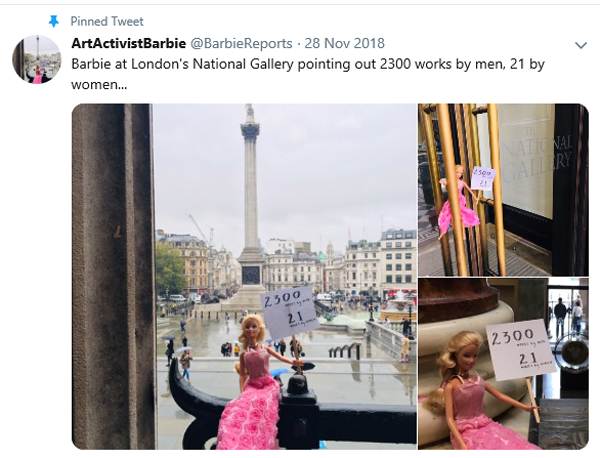
‘ArtActivistBarbie’ - promoting social justice and 'wokeness'

Sarah Williamson
HudCRES
Is iconic and internationally recognised Barbie an instrument of female oppression with her plastic white beauty and impossibly thin waist, or can she be mobilised as a political force to be a positive influence?
As a feminist, qualitative researcher and activist, I address ‘enduring and emergent questions of gendered social justice’, (Olesen, 2018, p. 151) through the staging and posing of Barbie dolls in art galleries and museums to draw attention to, and ask questions about, gender representation, inequalities and injustices. My work is part of a Canadian SSHRC-funded research project (see also Challenging gender representation, injustice and inequality through art gallery interventions) and it is a practice of intentionality, ‘intentionally bringing a political learning agenda to the table and reaching toward the kinds of political action and learning that are necessary’, (English & Irving, 2015, p. 3) for ‘wokeness’, justice, transformation and change.
Art galleries and museums are seen by many as trusted, authoritative and influential places and the ArtActivistBarbie project researches the potential of these places as spaces for action to educate for social justice and promote change. Hall, Evans and Nixon (2013) and Cramer and Witcomb (2018) state that museum and art gallery representations shape our identity - who we were, who we are and who we should be. The feminist, activist use of Barbie dolls in these spaces may be viewed as a form of ‘culture jamming’ (DeLaure, Fink and Deary, 2017) which can give agency through creative subversion and give voice via a form of radical ventriloquism. It is a site-specific pedagogical approach which can turn passive museum and gallery spaces into transformational arenas.
Staging Barbie dolls in art galleries and museums is an aesthetic and imaginative provocation, a public and performative critical practice that intervenes and disrupts representation.
‘We must take our work public’ exhorts feminist scholar Olesen (2018, p. 163), while Denzin and Lincoln (2018, p. 103) say that as qualitative researchers ‘we must learn how to act’ as ‘getting mad is no longer enough’. In addition, feminist scholar and curator Ashton (2017, p.47) states there is a ‘heightened need’ not only for publications and exhibitions, but also ‘practice-based work to demonstrate possibilities’. The feminist, activist work of ArtActivistBarbie responds to these calls to arms with performative work which seeks to activate critical feminist consciousness and an ‘oppositional gaze’ (hooks, 2010). ‘Playfulness has an unexpected quality ... perhaps because its essence is the combination of ideas that no one expected were combinable’ suggest Puwar and Sharma (2012, p. 44), and Barbie combines aesthetic playfulness with serious messages.
It can take courage and nerve on my part when she holds a mirror up (sometimes literally and sometimes using miniature placards made with lollypop sticks!) to cultural institutions, making comments and questioning them about visibly obvious and not-so-visibly-obvious patriarchal history, visuals and narratives.

I have developed a highly successful online social media presence on Twitter (see @BarbieReports), and am starting to consider the ‘potential of cyberspace to intervene for social justice’ (Olesen 2018, p. 163). One tweet shows ArtActivistBarbie at the National Gallery in London pointing out with a placard that there are 2300 works of art by men, and 21 by women. This tweet has reached over 94,000 twitter accounts in only 4 months, with over 10,000 people having engaged or interacted with the tweet in some way.
This has been a really surprising and yet exciting development of the work, and ArtActivistBarbie has been invited to present this at The Courtauld Institute of Art’s festival of art history research in London on 26th April 2019. In a further development, the National Gallery published a short online video during March 2019 in which they address the gender gap in art history and the gallery. In the video, the Director of Collections says the invisibility of women in the gallery had been of increasing concern to them and they were also responding to comments on social media.

Further sites for research will be a photographic exhibition of ArtActivistBarbie’s work at Manchester Central Library during July and August 2019, and this will include 2 participatory workshops open to the public to coincide with an online INTERNATIONAL ArtActivistBarbie FLASHMOB day to be held on Saturday 3rd August 2019. So, dig out your (old or new) Barbie dolls and get ready to go into any gallery or museum anywhere in the world to ask a question, make a comment or an observation about a societal issue of gender, race, class, power or privilege. Get ready to stage your own mini-activism! (details will be on Twitter).
ArtActivistBarbie has developed through the continued development of my arts-based pedagogy and research in art galleries and museums (see Williamson and Clover 2018, Clover and Williamson 2018, Clover and Williamson 2019) and playful object-based learning in higher education (see Exploration: Cabinets of Curiosities—Playing with Artefacts in Professional Teacher Education). The research is a form of ‘a/r/tographic’ inquiry, where the three roles of a(artist) and r(researcher) and t(teacher) coexist and combine as a ‘research methodology, a creative practice, and a performative pedagogy’ (Irwin 2012, p.198).The arts and aesthetic experience have the potential to ‘awaken us from our stock responses’ (Eisner 1995, p.2) and for Greene (1995, p.3), they can be connected to ‘becoming wide-awake to the world’ providing ‘new perspectives on the lived world’. In her well-known phrase, they can ‘release the imagination’, offering new lenses through which new perspectives, new vistas and new connections might be made, and encounters with the world might ‘become newly informed’ (p.18).
Can the texts of scholarly arts-based research ‘ever be educational in a profound sense?’ ask Barone and Eisner (2012, p. 70). Can university pedagogy, research and scholarship reach out beyond universities to penetrate, or at least touch, the public sphere, encouraging new or enhanced understandings of, or at least ‘a deeper curiosity toward’, social, political and educational issues?
Resonating with hooks (2010, p. 170) encouragement to use not only intellect, but also our ‘imaginations to forge new and liberatory ways of knowing, thinking and bring, to work for change’, it seems that ArtActivistBarbie may have found an imaginative way to do this through arts-based activism.